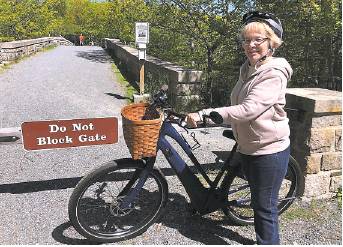Green light for e-bikes in national parks
By Peter Fimrite
Electric bicycle riders got the go-ahead from the Trump administration Friday to begin zipping around on trails in national parks, infuriating hiking, equestrian and outdoor user groups.
The new National Park Service policy would allow e-bikes wherever regular cyclists are permitted to ride in about 400 national parks and on federally managed open spaces, including the Golden Gate National Recreation Area, Point Reyes National Seashore and Yosemite National Park.
It means e-cyclists can whir along fire trails, paved or hardened park trails, and areas designated for off-road motor vehicles as long as they continue pedaling.
“National parks should be responsive to visitors’ interest in using this new technology wherever it is safe and appropriate to do so,” said P. Daniel Smith, the park service’s deputy director.
Interior Secretary David Bernhardt on Thursday issued a directive classifying e-bikes as non-motorized vehicles and ordering agencies to develop rules allowing them on park roads. A public comment period will be held before the e-bike policy, which the park service announced Friday, is implemented.
Trail user groups, including the Pacific Crest Trail Association, American Hiking Society and the Back Country Horsemen of America, blasted the decision Friday for not including any analysis of the impacts to natural and cultural resources, trail conditions or visitors.
“It’s a terrible, cynical policy,” said Neal Desai, senior program director for the pacific region of the National Parks Conservation Association. “It’s almost like the administration thinks it’s good politics to damage our parks. We’re talking about damage to wildlife and wildlife habitat ... and this policy is going to be inviting more conflict with other users of the trails.”
E-bikes are the fastestgrowing segment of the bicycle industry and are extremely popular among Bay Area commuters, who pay from $2,000 to $5,000 or more for the contraptions or rent them from a growing number of vendors with fleets on San Francisco streets.
U.S. sales jumped 72% to $144 million last year, according to market research firm NPD Group, which tracks bike sales.
The two-wheelers, which run on lightweight, chargeable battery packs, may be popular on the streets, but they’re one more thing for people to fight over in the hilly open spaces of the Bay Area. Mountain bikers have long fought hiking groups, bird watchers and equestrians for the right to use trails, and nobody thinks that a bunch of e-bikers humming across the landscape will ease tensions.
The e-bikes come in three classes, based on how much electric assistance the riders get. The new policy would allow all three classes, the fastest reaching 28 mph with minimal pedaling.
The order also applies to land managed by the National Wildlife Refuge System, the Bureau of Land Management and Bureau of Reclamation. It will be up to each unit to come up with its own regulations.
The policy requires riders to use the motor only to assist pedal propulsion except in areas where motor vehicle traffic is allowed.
Not all nature lovers are opposed to the policy, and bicycling groups generally support the new rules.
Tarrell Kullaway, executive director of the Marin County Bicycle Coalition, said e-bikes allow people of all ages and abilities to get out of their cars and access parks and trails.
“So few of the trails allow bicycles to begin with, and this policy is only for trails where bicycles are allowed,” said Kullaway, adding that the local and regional parks that already allow (e-bikes) have not reported any problems. “This is a way for people who are physically impaired and not as fit as they were when they were younger to continue the sport they are so passionate about in their older years.”
Greg Adair, co-founder and director of Friends of Yosemite Valley, said it would be a very good thing if the policy prompted Yosemite tourists to get out of their cars.
“The availability of bicycles will improve the congestion problem,” Adair said. “But it would not be good if people started riding into wilderness areas. Ideally, they will have a place for people to put bikes if they want to get off and walk a trail. I just think there needs to be a clear division.”
But Desai and others believe the policy is actually part of a larger plot by Trump and Bernhardt to loosen restrictions and eventually open up wilderness areas to offroad vehicles, oil and gas exploration, and logging.
“This is fitting into a pattern of behavior to damage our parks, and Bernhardt has been leading the charge,” Desai said.
More than 50 trail advocate, hunting, backpacking and conservation groups recently signed a letter to federal land management officials saying the e-bike plan violates policies dating back to the early 1970s confining motorized vehicles to roads and designated areas.
“Let’s be clear, e-bikes are motorized vehicles,” said Michael Carroll, senior director of the People Outdoors Program at the Wilderness Society. “Secretary Bernhardt’s policy change paves the way for the complete motorization of America’s remaining wild places.”
Peter Fimrite is a San Francisco Chronicle staff writer. Email: pfimrite@sfchronicle.com. Twitter: @pfimrite

